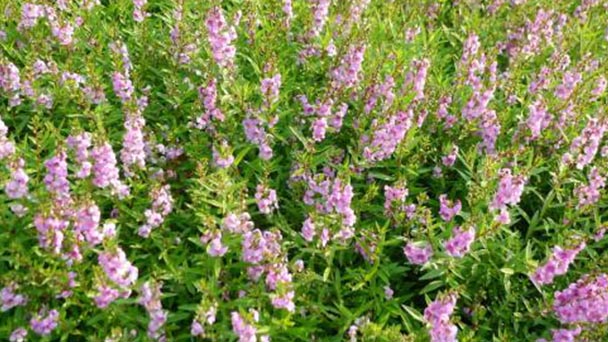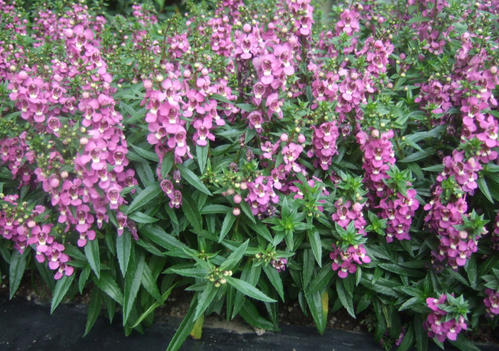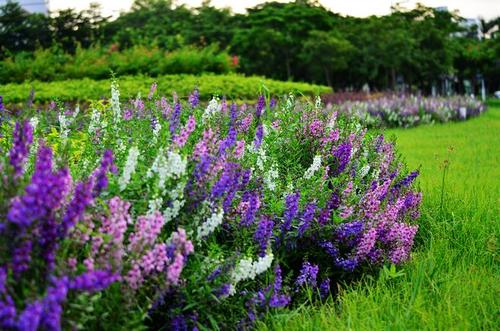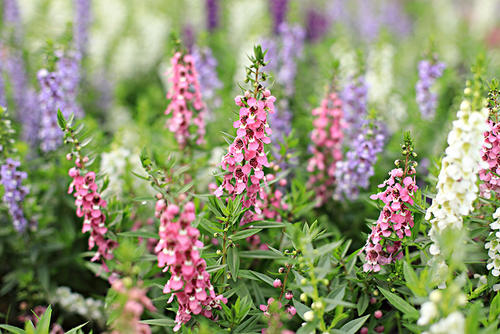Angelonia Plant (Angelonia Angustifolia) Profile
Written by Maggie
Oct 28 2021

Angelonia (Angelonia angustifolia) is a perennial herbaceous plant of the family Angelonia, originally from South America. It is also known as summer snapdragon. It is a new variety of summer flowers.
Angelonia has rich and gorgeous colors, white, red, pink, pink-purple, blue-purple and other colors, the characteristics of long flowering, flowers are small, but the color is quietly elegant, a large number of flowers, and constantly blooming, long ornamental period, and do not leave residual flowers. angelonia is easy to maintain, salt and alkali resistance, high temperature and high humidity climate also have strong adaptability, maintenance is very easy, is an excellent grass variety.
Angelonia is usually cultivated as an annual, pot plant height of 25--35cm, ground plant height of 40--60cm, crown width of 30-- 35cm. Strongly branched, compact, and plump.
Angelonia Picture

Angelonia Info
| Botanical Name | Angelonia angustifolia |
| Common Names | Angelonia; summer snapdragon |
| Plant Type | Tender perennial |
| Sun | Full sun |
| Hardiness Zones | USDA growing zones 9–11 |
| Flower color | White, pink, purple |
| Native Area | Mexico and the West Indies |
| Mature size | 18 inches |
Characteristics of Angelonia
Angelonia is a perennial herb, plant height 40~60cm, all glandular hair. Leaves are opposite or distally alternate, sessile, lanceolate or striate-lanceolate, with sparse teeth, pointed and curved toward the tip of the leaves, flowers solitary in axils, petals labial, upper four-lobed, pedicels slender.
Angelonia plants are 30-70cm in height, with lip-shaped petals and four-lobed upper petals. They bloom all year-round and bloom most in spring, summer and autumn. The flowers are purple, light purple, pink-purple, white and so on. Capsule, small seed, rarely fruits.
Habits of Angelonia
Angelonia likes warm, high temperature resistant, not cold-resistant, strong adaptability to air humidity, light-loving, loose, fertile and well-drained soil.
How to Propagate Angelonia
The method of Angelonia propagation is sowing or intercropping, with a high survival rate, and spring to autumn is the suitable period. The Angelonia likes high temperature and wet, the cultivation place is best to accept the full sunshine is better, the micro shade place, the cultivation soil is not limited, the drainage is good.
Seed propagation pelletized seeds, 1000s/g.
How to Care for Angelonia
Angelonia Lighting Requirments
Give your angelonia plants a full day of sun to provide the energy plants need to bloom continuously. Plants that don't get at least six hours of direct sunlight will get leggy and will have sparse blooms.
Angelonia Soil Care
Angelonia plants are tolerant of a wide variety of soils, but a soil rich in organic matter will reduce watering and fertilizing chores. Plants need good drainage to prevent root rot, so if you have heavy clay consider growing angelonia in raised beds or containers.
Angelonia Watering
Angelonia plants are tough and will keep on blooming through periods of drought. Water when the top of the soil feels dry. Additional moisture is fine if the plants have good drainage.
Angelonia Temperature & Humidity
Angelonia plants love hot summer weather and high humidity. They thrive in the deep South when sultry conditions dominate. Angelonia plants also fare well in the Southwest, with a little extra watering.
Angelonia Fertilizer
Fertilize your angelonia plants monthly, as they are light feeders and too much fertilizer will cause an overgrowth of foliage at the expense of flowers. You can also choose a balanced flower fertilizer with a timed-release mix of a 10-5-10 or 12-12-12 fertilizer at planting time, which will eliminate the need to fertilize again.
Angelonia Pruning
Unlike many annuals, angelonia plants don't require deadheading to promote blooming. However, cutting the plants back promotes bushier growth.

Species of Angelonia
Angelonia peanut axils, gradually open from the bottom to the top, petals lipped, the upper four-lobed; There are strong purple, light purple, pink, white, and two colors. The Banna Botanical Garden preserves two of these species.
Distribution of Angelonia
Angelonia originated in South America, Angelonia is cultivated in Guangdong, Hainan and other places in China. Now, the new varieties that are cultivated in the West in recent years are cultivated.
Because of its good ornamental performance and high temperature and humidity resistance, Angelonia has broad application prospects in hot areas.
Uses of Angelonia
Ornamental value
Although angelonia flowers are small, they are small in shape, elegant in color, large in quantity, continuous in blossom and long in ornamental period. Moreover, Angelonia has strong adaptability to hot and high-temperature climates. As one of the excellent grass and flower varieties, Angelonia can be planted on the ground, in a pot or in container combination.
Potted role
Angelonia can be used as flower beds and terraces, and because of its resistance to moisture, it is also cultivated as an aquatic plant.
A hydroponic ornamental
In addition to the land culture of pot and ground, Angelonia can also adapt to the aquatic culture. It was introduced and planted in shallow water in Xishuangbanna Tropical Botanical Garden in 2003 and has grown well. After several years of large-scale application in Xiamen, the effect is remarkable. Due to its good ornamental quality and high temperature and humidity resistance, Angelonia is also widely used as the flower variety for the Beijing Olympic Games.
Daily tea
Angelonia can also be used as a tea and is usually used to add color to the tea.

Read Next:
Top 10 Most Beautiful Roses in the World
Top 10 Most Beautiful Flowers in the World
26 Best Autumn Flowers to Plant for Fall Color in Garden
Latest Updated
- Benefits of Bugleweed - 7 Science-backed Health Benefits
- Bugleweed Dangers & Side Effects - Is It Poisonous?
- How to Plant Evergreen Trees - What You Should Know
- When to Plant Evergreens - Grow Guide for Evergreen Trees
- 12 Wonderful Evergreen Shrubs for Your Garden
- 12 Popular Evergreen Plants with Pictures for Beginners
- When And How To Prune A Lilac Bush Like a Pro
- How to Grow & Care for Lilac Vine (Hardenbergia Violacea)
- Japanese Lilac Tree (Syringa Reticulata) Care & Propagation Guide
- Shumard Oak Pros and Cons - What to Know
Popular Articles
- Winter maintenance of Antirrhinum Majus
- How to Grow Terminalia Mantaly Tree
- How to Grow and Care for Crossostephium Chinense
- How to grow Antirrhinum Majus in spring
- Peristeria Elata (Dove Orchid) Profile: Info & Care Guide
- Underwatered Snake Plant (Sansevieria Trifasciata) - Signs And How To Fix
- How to Care for Brazilian Jasmine Plant (Mandevilla Sanderi)
- How to Grow & Care for Graptopetalum Purple Delight in Summer
- Rosa Chinensis (China Rose): Plant Growing & Care Tips
- How to Care for Baby Sun Rose (Aptenia Cordifolia)